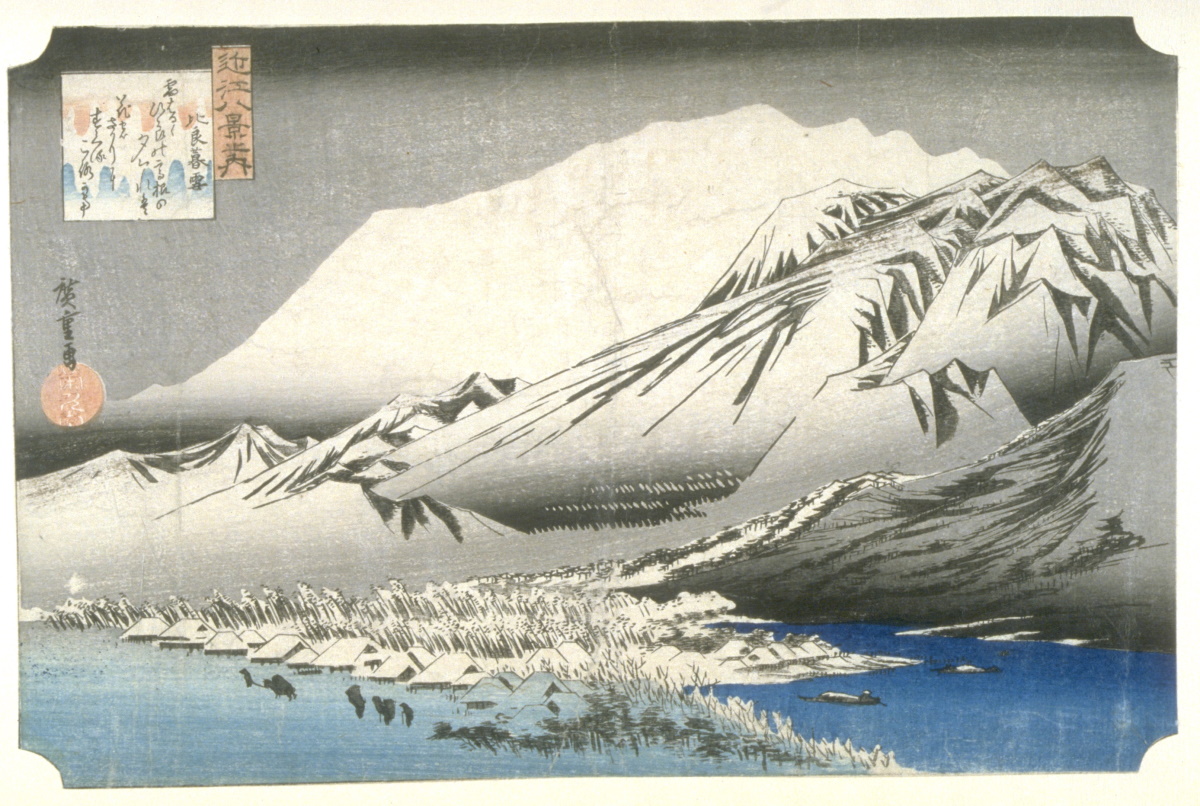
Utagawa Hiroshige
Japanese, 1797-1858
"Lingering Snow on Mount Hira"
From Eight Views of Ōmi
ca. 1834, Edo period
Color woodblock print on paper
On loan from the University of Michigan Museum of Art
Bequest of Margaret Watson Parker, 1948.1.134
Hiroshige depicts Mount Hira as a series of snow-covered slopes and crags folded almost like crumpled paper as they rise to the right. The silhouette of a distant mountain blanketed in snow provides the backdrop, and the gray sky signals night soon will fall. In the lower right corner, the cold blue water of Lake Biwa provides the only strong color in the image. Several boats linger close to the shore of a fishing village. Snow covers the roofs of the simple houses, and a line of figures rendered as dark silhouettes approach the village, perhaps hoping for a place to stay for the night. The only hint that spring might be coming is the dark patches on the mountainsides where snow has started to melt. In the square in the upper left, Hiroshige includes a poem written by Konoe Nobutada centuries earlier that complements his image:
-
When it clears after snowfall
the tops of Mount Hira
at dusk surely surpass
the beauty of cherry trees in bloom
During the Edo period, there was growing interest in meisho—the famous and scenic places of Japan. This print is part of a series of eight depicting Ōmi province, about 200 miles west of Tokyo and accessible via two major roads. The red rectangle next to the poem box records the title of the series and of the print, and Hiroshige's signature and the seal of his publisher appear below. Mount Hira, a range rather than a single peak, is located along Lake Biwa, a place that had inspired centuries of writers and artists. For those who could not journey to the province, Hiroshige's publisher hoped they would buy this print, or perhaps the entire series. Hiroshige, like Hokusai, was commissioned to create designs for numerous series focusing on the varied landscapes of Japan. Hiroshige's prints were popular because of his innovative designs, his use of a new synthetic color, Prussian Blue, and the incorporation of subtle gradation of color at (bokashi) at the top and bottom of the print. These changing shades hint at a landscape as unseen and enticing as the scent of cherry blossoms in Nobutada's poem.
Bibliography
Baker, Jennifer. "The Eight Views: From Its Origin in the Xiao and Xiang Rivers to Hiroshige." Master's Thesis, University of Canterbury, 2010.
Forrer, Matthi. Hiroshige: Prints and Drawings. Munich: Prestel-Verlag, 1997.
Uhlenbeck, Chris, and Marie Jansen. Hiroshige: Shaping the Image of Japan. Amsterdam: Hotei Publishing, 2008.